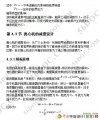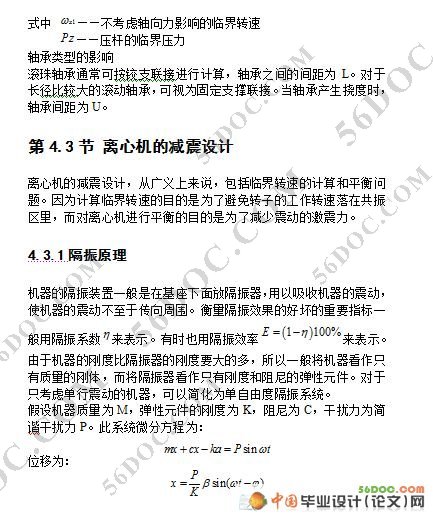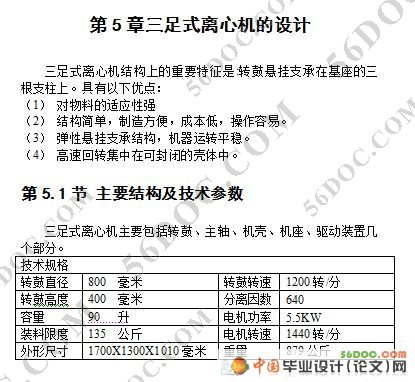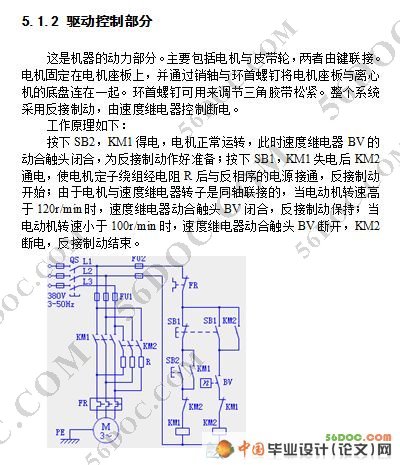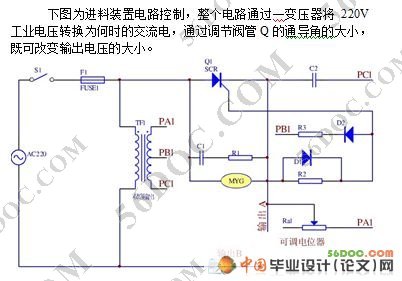摘要
离心机是利用离心力,分离液体与固体颗粒或液体与液体的混合物中各组分的机械。
离心机主要用于将悬浮液中的固体颗粒与液体分开;或将乳浊液中两种密度不同,又互不相溶的液体分开(例如从牛奶中分离出奶油);它也可用于排除湿固体中的液体,例如用洗衣机甩干湿衣服;特殊的超速管式分离机还可分离不同密度的气体混合物;利用不同密度或粒度的固体颗粒在液体中沉降速度不同的特点,有的沉降离心机还可对固体颗粒按密度或粒度进行分级。
离心机大量应用于化工、石油、食品、制药、选矿、煤炭、水处理和船舶等部门。
中国古代,人们用绳索的一端系住陶罐,手握绳索的另一端,旋转甩动陶罐,产生离心力挤压出陶罐中蜂蜜,这就是离心分离原理的早期应用。
工业离心机诞生于欧洲,比如19世纪中叶,先后出现纺织品脱水用的三足式离心机,和制糖厂分离结晶 砂糖用的上悬式离心机。这些最早的离心机都是间歇操作和人工排渣的。
由于卸渣机构的改进,20世纪30年代出现了连续操作的离心机,间歇操作离心机也因实现了自动控制而得到发展。
【关键词】 离心机 电机驱动 旋转 离心沉降
Abstract
Centrifugal separation, centrifuge is using liquid and solid particles or liquid and liquid mixture of mechanical components.
The centrifuge is mainly used for solid particles and will suspension liquid separated, In the emulsion or two different from each other, the liquid phase dissolved apart from milk (such as isolated cream), It can also be used to eliminate the liquid, such as wet solid with wet clothes washing machine, Special speeding tubular centrifuges are separable different density of the gas mixture, Use different density and particle size of solid particles in the liquid settling velocity different characteristics, but also on the settlement of centrifuge solid particles by density or selecting.and.
A centrifuge used in chemical, petroleum, food, pharmaceutical, dressing, coal, water treatment and shipping department.
In ancient China, people use rope tied at the end of the clay, the other end of the rope hand, rotate, rotating centrifugal extruded clay POTS of honey, this is the principle of centrifugal separation of early.
Born in Europe industrial centrifuge, such as the middle of the 19th century, successively appeared three feet in textile dewatering centrifuge, and billows of the separation of sugar in the floating.the centrifuge. The earliest centrifuge is intermittent operation and artificial slag discharge.
Slag discharge due to the improvement of the organization, the 1930s appeared continuous operation of centrifuge, intermittent operation centrifuge for realizes automatic control and development.
【Keywords】 Centrifuge Motor driver rotating
Centrifugal sedimentation
离心机总体设计
经过调研了解到,国内市场对于三足式离心机的需求量比较大,考虑到国内的特点,从实用角度出发,确定如下方案:
1. 考虑到大多数使用者对于离心设备使用频繁,出料系统采用成本相对较低但使用方便的设计。
2. 为了减少工作量使用定量进料装置。
3. 离心机的制动装置采用反接制动。
4. 在满足上述要求的同时,尽量结构简单,操作方便,适用于整体或解体搬运尽量做到标准化,通用化,系列化。
目 录 24000字
摘要 I
ABSTRACT II
第1章 绪论 1
第1.1节 前言 1
第1.2节 离心机的概述 1
第1.3节 离心机总体设计 3
第2章离心机技术特点及其技术参数 3
第2.1节 离心力场的基本特性 3
2.1.1 分离因数Fr 3
2.1.2 沉降速度Vc 4
第2.2节 分离物料的特性 5
2.2.1 悬浮液特性 5
2.2.2 固体颗粒特性 5
第3章转鼓的强度计算 6
第3.1节 高速回转圆筒的应力和形变 6
3.1.1 鼓壁质量的离心力引起的应力和形变 6
3.1.2 物料离心压力引起的鼓壁应力和形变 8
第3.2节 筛网等附件的离心力引起的鼓壁应力和形变 8
第3.3节 轴对称边界载荷作用下的圆筒壳体 9
3.3.1 一般情况 9
3.3.2沿一边缘受力矩M作用的圆筒 11
第4章 离心机的震动 13
第4.1节 离心机临界转速的计算 13
第4.2节 影响临界转速的其他因素 14
第4.3节 离心机的减震设计 15
4.3.1隔振原理 15
4.3.2隔振器的选择 17
第5章三足式离心机的设计 18
第5.1节 主要结构及技术参数 19
5.1.1 机械主要部件 19
5.1.2 驱动控制部分 20
第5.2节 转鼓的强度计算 21
第5.3节 减震系统的选择 23
第5.4节 离心机主要工作参数的计算 24
第5.5节 离心机功率计算 26
5.5.1 功率消耗的计算 26
5.5.2 轴功率的计算 27
5.5.3 电机功率的确定 28
第6章自动进料系统 29
第6.1节 输送器计算 29
6.1.1直线段运行阻力 29
6.1.2曲线段运行阻力 31
6.1.3其他阻力 33
6.1.4 工作过程的分析 34
第6.2节 电动机功率计算 34
6.2.1 阻力的计算 34
6.2.2 电动机功率的确定 35
第6.3节 传送带的计算 36
6.3.1输送带的计算安全系数 37
6.3.2输送带允许安全系数 37
6.3.3输送带强度验算 38
第6.4节 称重传感器 38
6.4.1 称重原理 38
6.4.2称重特点 39
6.4.3称重传感器选择 39
第7章电路控制 41
第7.1节 进料装置原理 41
第7.2节 称重系统工作原理 41
第7.3节 工作流程 42
第7.4节 V/F型模数转换 43
第7.5节 电机的反接制动 44
参考文献 45
英文原文 47
中文译文 58
附录 65
致谢 66
|
